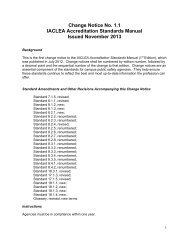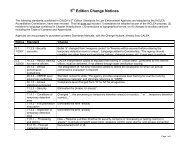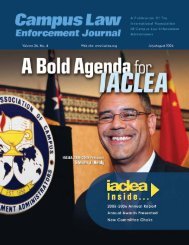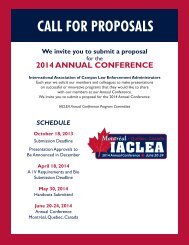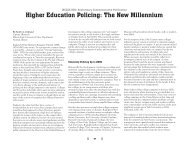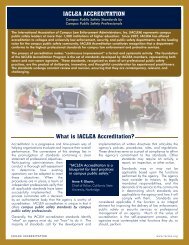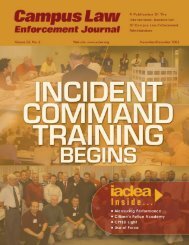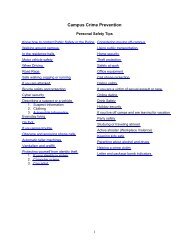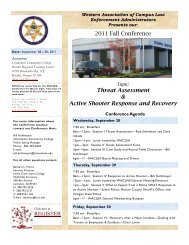4th Edition Standards - IACLEA
4th Edition Standards - IACLEA
4th Edition Standards - IACLEA
You also want an ePaper? Increase the reach of your titles
YUMPU automatically turns print PDFs into web optimized ePapers that Google loves.
<strong>4th</strong> <strong>Edition</strong> <strong>Standards</strong><br />
Chapter Standard Title/Subject<br />
Role & Authority 1.1.1 Oath of office<br />
1.1.2 Code of ethics<br />
1.2.2 Legal authority to carry/use weapons<br />
1.2.3 Procedures - Constitutional requirements<br />
1.2.4 Search & seizure without warrant<br />
1.2.5 Procedures - arrest with/without warrant<br />
1.2.6 Alternatives to arrest<br />
1.2.8 Procedures - strip/body cavity searches<br />
1.2.9 Bias based profiling prohibited<br />
1.3.1 Use only necessary force<br />
1.3.2 Proscribes use of deadly force<br />
1.3.3 Warning shots<br />
1.3.4 Less lethal weapons<br />
1.3.5 Procedures - medical aid after use of force<br />
1.3.6 Reporting use of force incidents<br />
1.3.8 Removal from line duty<br />
1.3.9 Authorization of weapons and ammunition<br />
1.3.9-A<br />
1.3.10 Weapons proficiency required<br />
1.3.11 Annual use of force training<br />
1.3.12 Issuance of orders re weapons<br />
Jurisdiction & Mutual Aid 2.1.1 Geographical boundaries<br />
2.1.2 Responsibilities re concurrent jurisdiction<br />
2.1.4 Federal law enforcement/Nat'l Guard<br />
Organization & Admin 11.1.1 Written description of organizational structure<br />
11.1.2 Organizational chart<br />
11.2.1 Unity of command<br />
11.3.1 Responsibility and authority<br />
11.3.2 Supervisory accountability<br />
11.5.1 Written goals and objectives<br />
11.5.2 Evaluating progress<br />
Direction 12.1.1 Designation of responsibility of CEO<br />
12.1.2 Command protocol<br />
12.1.3 Obeying lawful orders<br />
12.2.1 Written directive system<br />
12.2.2 Dissemination of written directives<br />
Personnel Alternatives 16.3.2 Selection of reserve officers same as full-time<br />
16.3.3 Recruit training for reserve officers<br />
16.3.5 In-service training for reserve officers<br />
16.3.6 Use of force training for reserve officers<br />
16.4.2 Training for auxiliary officers<br />
Fiscal Management 17.4.2 Maintenance of cash accounts<br />
Page 1
<strong>4th</strong> <strong>Edition</strong> <strong>Standards</strong><br />
Chapter Standard Title/Subject<br />
Conditions of Work 22.3.4 Extra-duty employment<br />
Disciplinary Procedures 26.1.1 Code of conduct and appearance guidelines<br />
26.1.2 Recognition for good performance<br />
26.1.3 Sexual harassment prohibited<br />
26.1.4 Disciplinary system<br />
26.1.5 Role of supervisors in discipline<br />
26.1.6 Appeal procedures in disciplinary actions<br />
Recruitment 31.1.1 Participates in recruitment program<br />
31.1.1-A<br />
31.2.3 EEO plan<br />
31.3.1 Job announcements<br />
31.3.1-A<br />
Selection 32.1.1 Describes selection process<br />
32.1.1-A<br />
32.1.2 Selection process is job related<br />
32.1.2-A<br />
32.1.3 Selection process applied uniformly<br />
32.1.3-A<br />
32.2.1 Background investigation<br />
32.2.1-A<br />
32.2.4 Polygraph questions provided to applicants<br />
32.2.5 Polygraph examiners are trained<br />
32.2.6 Polygraph results are not single determinant<br />
32.2.7 Medical examination<br />
32.2.7-A<br />
32.2.8 Psychological examination<br />
32.2.8-A<br />
Training 33.1.1 Establishes training committee<br />
33.1.2 Attendance at authorized training<br />
33.1.4 Lesson plans<br />
33.1.6 Update training records<br />
33.1.7 Records of all classes<br />
33.2.1 Administration of training academy<br />
33.2.2 Training academy facilities<br />
33.2.3 Relationship between agency/outside academy<br />
33.2.5 Training by outside academy<br />
33.3.1 Qualifications of full-time instructors<br />
33.4.1 Entry level training<br />
33.4.1-A<br />
33.4.3 Field training<br />
33.4.3-A<br />
33.5.1 Annual retraining<br />
33.5.1-A<br />
33.5.2 Shift briefing training<br />
Page 2
<strong>4th</strong> <strong>Edition</strong> <strong>Standards</strong><br />
Chapter Standard Title/Subject<br />
33.6.1 Specialized training<br />
33.6.2 Tactical training<br />
33.8.2 Training to newly promoted personnel<br />
Performance Evaluation 35.1.1 Defines performance evaluation system<br />
35.1.2 Annual performance evaluations<br />
35.1.4 Criteria for performance evaluation<br />
35.1.5 Requirements for personnel evaluation system<br />
35.1.7 Explanatory comments<br />
35.1.8 Evaluations signed by rater's supervisor<br />
35.1.9 Employee counseled<br />
35.1.10 Employee signature and comments<br />
35.1.11 Copy of evaluation given to employee<br />
35.1.12 Appeal process for contested evaluations<br />
35.1.13 Retention of performance evaluation reports<br />
35.1.14 Raters evaluated by supervisors<br />
Patrol 41.1.1 Continuous patrol coverage<br />
41.1.1-A<br />
41.1.2 Describes patrol coverage<br />
41.1.3 Describes method of shift briefing<br />
41.1.4 Operation of special-purpose vehicles<br />
41.2.1 Procedures - response to calls<br />
41.2.2 Pursuit of motor vehicles<br />
41.2.4 Field interviews<br />
41.2.5 First responder notifications<br />
41.2.6 Procedures - adult missing persons<br />
41.3.1 Emergency lights and siren<br />
41.3.1-A<br />
41.3.2 Patrol vehicle equipment and supplies<br />
41.3.3 Use of safety restraints<br />
41.3.4 Equipment and apparel of uniformed officers<br />
41.3.5 Body armor availability<br />
41.3.6 Body armor use (high risk)<br />
Criminal Investigation 42.1.1 24-hour service capabilities<br />
42.1.4 Accountability for follow-up investigations<br />
42.2.1 Procedures in criminal investigations<br />
42.2.2 Preliminary investigations<br />
42.2.3 Follow-up investigations<br />
42.2.4 Investigation checklists<br />
42.2.9 Use of informants<br />
Crime Prevention 45.1.1 Crime prevention function<br />
45.1.2 Organizing crime prevention groups<br />
45.1.3 Crime prevention input<br />
45.2.1 Community involvement function<br />
45.2.2 Community involvement quarterly report<br />
Page 3
<strong>4th</strong> <strong>Edition</strong> <strong>Standards</strong><br />
Chapter Standard Title/Subject<br />
45.2.3 Transmission of information<br />
45.2.4 Documented citizen survey of attitudes<br />
Special Operations 46.1.1 Critical incident planning<br />
46.1.2 All hazards plan<br />
46.1.3 Mass arrests<br />
46.1.4 Hostage/barricaded person<br />
46.1.5 Bomb threat<br />
46.1.6 Emergency equipment inspection<br />
46.1.7 Access and review of plans<br />
46.1.8 Emergency mobilization<br />
46.1.9 VIP security plans<br />
46.1.10 Plans for special events<br />
46.2.1 Procedures - special operations activities<br />
46.2.2 Selection to tactical operations section<br />
46.2.3 Tactical team specialized equipment<br />
46.2.4 Selection of hostage negotiators<br />
46.2.5 Procedures - search and rescue<br />
Internal Affairs 52.1.1 Complaint investigations<br />
52.1.2 IA function reports to CEO<br />
52.1.3 CEO notification of complaints<br />
52.1.4 Time limit for Internal Affairs Investigations<br />
52.1.5 Inform complainant of status<br />
52.1.6 Inform employee of allegations<br />
52.1.9 Conclusion of fact required<br />
Public Information 54.1.1 Public information function<br />
54.1.2 Media involved in changes to PIO policies<br />
54.1.3 Control of media access<br />
Victim/Witness Assistance 55.1.1 Rights of victims and witnesses<br />
55.1.2 Review of victim/witness assistance needs<br />
55.1.3 Agency's role in victim/witness assistance<br />
55.2.1 Availability of information<br />
55.2.2 Assistance when threatened<br />
55.2.3 Services during preliminary investigation<br />
55.2.4 Services during follow-up investigation<br />
55.2.5 Services following arrest<br />
55.2.6 Death/injury notifications<br />
Traffic 61.1.2 Procedures - enforcement action<br />
61.1.3 Procedures - special processing requirements<br />
61.1.4 Information for motorist<br />
61.1.5 Uniform enforcement policies<br />
61.1.7 Procedures - motorist stops<br />
61.1.8 Procedures - violator contact<br />
61.1.9 Speed measuring devices<br />
Page 4
<strong>4th</strong> <strong>Edition</strong> <strong>Standards</strong><br />
Chapter Standard Title/Subject<br />
61.1.10 Alcohol/drug countermeasures<br />
61.1.11 Procedures - DUI<br />
61.1.12 Procedures - reexamination referral<br />
61.1.13 Parking enforcement activities<br />
61.2.1 Collision reporting and investigation<br />
61.2.2 Response to collision scene<br />
61.2.3 Responsibilities of responding officers<br />
61.3.1 Traffic engineering<br />
61.3.3 Escorts<br />
61.3.4 Roadblocks<br />
61.4.1 Assistance to highway users<br />
61.4.2 Correction of highway hazards<br />
61.4.3 Procedures - abandoned vehicles<br />
61.4.4 Traffic safety public education<br />
Prisoner Transportation 71.1.1 Search of detainee<br />
71.1.2 Search of vehicle prior to/after transport<br />
71.1.3 Seating of detainees<br />
71.1.4 Interruption of transport<br />
71.1.5 Communication by detainee<br />
71.1.6 Officer's actions at destination<br />
71.1.7 Escapes<br />
71.1.8 Security risks<br />
71.2.1 Restraining devices<br />
71.3.1 Transporting sick, injured, disabled detainees<br />
71.3.2 Transport to medical facilities<br />
71.4.1 Driver safety barrier<br />
71.4.2 Rear compartment modifications<br />
Holding Facility 72.1.1 Training for operations of holding facility<br />
72.2.1 Minimum conditions<br />
72.3.1 Fire, heat and smoke detection<br />
72.3.2 Emergency evacuation plan<br />
72.4.1 Securing firearms<br />
72.4.5 Security check of unoccupied cell<br />
72.4.7 Control of tools and culinary equipment<br />
72.4.8 Emergency alert of control point<br />
72.5.1 Control of detainee's property<br />
72.5.2 Storage of detainee's property<br />
72.5.3 Intake form<br />
72.5.4 Separation of females and juveniles<br />
72.5.5 Segregation of detainees under the influence<br />
72.5.6 Identification of presenting party<br />
72.5.7 Group arrests<br />
72.5.8 Positive identification prior to release<br />
72.5.9 Return of detainee's property<br />
72.6.1 Procedures - medical assistance<br />
72.6.2 First aid kit<br />
Page 5
<strong>4th</strong> <strong>Edition</strong> <strong>Standards</strong><br />
Chapter Standard Title/Subject<br />
72.6.3 Receiving screening<br />
72.6.5 Distribution of medications<br />
72.8.1 Visual observation and monitoring<br />
72.8.2 Audio/visual surveillance<br />
72.8.4 Receipt of mail/packages<br />
72.8.5 Procedures - visiting detainees<br />
72.9.1 Procedures - temporary detention<br />
72.9.2 Conditions of temporary holding area<br />
72.9.3 Maximum two hour detention<br />
72.9.4 Securing to immovable objects<br />
72.9.5 Fire prevention/evacuation<br />
72.9.6 Security concerns<br />
72.9.7 Training<br />
Communications 81.1.1 Authority/responsibility for communications<br />
81.1.2 FCC requirements<br />
81.2.1 24-hour toll-free access<br />
81.2.2 Single emergency telephone number<br />
81.2.3 Continuous communication with officers<br />
81.2.4 Procedures - recording information<br />
81.2.5 Procedures - radio communications<br />
81.2.6 Access to resources<br />
81.2.7 Procedures - calls for service<br />
81.2.8 Immediate play-back<br />
81.2.11 Emergency messages<br />
81.2.12 Handling misdirected calls<br />
81.2.13 Private security alarms<br />
81.2.15 First aid instruction training<br />
81.3.2 Alternative power source<br />
81.3.3 Separate emergency/routine telephone calls<br />
Records 82.1.1 Security of records<br />
82.1.2 Record retention schedule<br />
82.1.3 Procedures - collecting/submitting crime data<br />
82.1.4 Records accessible to operations personnel<br />
82.1.5 Status of initial reports<br />
82.1.6 Annual audit of computer system<br />
82.1.7 Outside software<br />
82.1.8 Computer security<br />
82.1.9 Access to criminal histories<br />
82.2.1 Field reporting system<br />
82.2.2 Required incident reporting<br />
82.2.3 Case numbering system<br />
82.2.4 Supervisory review of reports<br />
82.2.5 Distribution of reports and records<br />
82.3.1 Alphabetical master name index<br />
82.3.2 Contents of records<br />
82.3.4 Records of traffic citations<br />
Page 6
<strong>4th</strong> <strong>Edition</strong> <strong>Standards</strong><br />
Chapter Standard Title/Subject<br />
82.3.5 Records in operational components<br />
82.3.6 Arrestee's ID number and criminal history<br />
82.3.7 Arrest information criteria<br />
82.3.8 Warrant/wanted persons file<br />
Evidence Collection 83.1.1 24 hour availability of qualified personnel<br />
83.1.2 Collection from known source<br />
83.2.1 Procedures - collecting/preserving evidence<br />
83.2.2 Procedures - photography/video taping<br />
83.2.3 Procedures - fingerprinting<br />
83.2.4 Resources to process scenes<br />
83.2.5 Procedures - seizing computers<br />
83.2.6 Report preparation<br />
83.3.1 Documentation of evidence transfer<br />
83.3.2 Procedures - submission for laboratory analysis<br />
Property/Evidence Control 84.1.1 Receipt of property/evidence<br />
84.1.2 Secure property/evidence storage<br />
84.1.3 Secure property/evidence temporary storage<br />
84.1.4 Limited access to storage areas<br />
84.1.5 Property records system<br />
84.1.6 Audit and inspections<br />
84.1.7 Timely disposition of property<br />
Campus Public Safety 85.1.1 Agency's role in Annual Campus Security Report<br />
85.1.2 Procedures - timely warning<br />
85.1.3 Daily crime log<br />
TOTAL<br />
275 (-14 "A"s)<br />
Revised - November 2006<br />
Page 7



